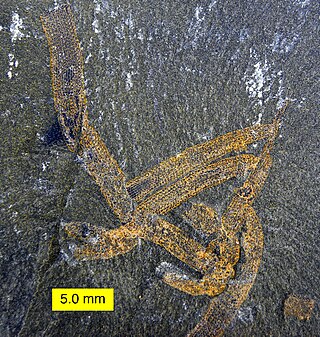
Vauxia is an extinct genus of demosponge that had a distinctive branching mode of growth. Each branch consisted of a network of strands. Vauxia also had a skeleton of spongin common to modern day sponges. Much like Choia and other sponges, Vauxia fed by extracting nutrients from the water.
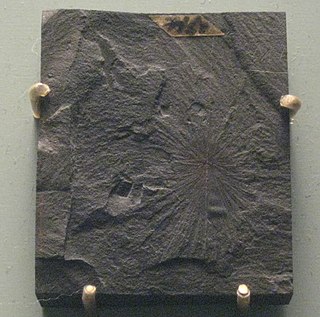
Choia is a genus of extinct demosponge ranging from the Cambrian until the Lower Ordovician periods. Fossils of Choia have been found in the Burgess Shale in British Columbia; the Maotianshan shales of China; the Wheeler Shale in Utah; and the Lower Ordovician Fezouata formation. It was first described in 1920 by Charles Doolittle Walcott.

Chancelloria is a genus of early animals known from the Middle Cambrian Burgess Shale, the Comley limestone, the Wheeler Shale, the Bright Angel Shale and elsewhere. It is named after Chancellor Peak. It was first described in 1920 by Charles Doolittle Walcott, who regarded them as one of the most primitive groups of sponges. However, they are currently thought to be member of the group Chancelloriidae. 178 specimens of Chancelloria are known from the Greater Phyllopod bed, where they comprise 0.34% of the community.

Capsospongia, formerly known as Corralia or Corralio, is a middle Cambrian sponge genus known from 3 specimens in the Burgess shale. Its type and only species is Capsospongia undulata. It has a narrow base, and consists of bulging rings which get wider further up the sponge, resulting in a conical shape. Its open top was presumably used to expel water that had passed through the sponge cells and been filtered for nutrients.
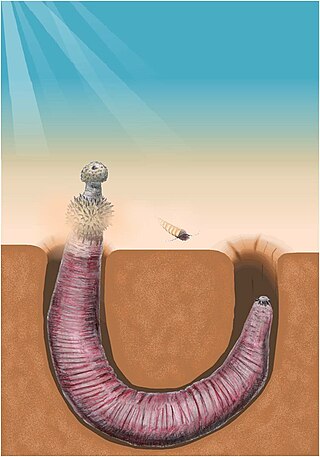
Archaeopriapulida is a group of priapulid worms known from Cambrian lagerstätte. The group is closely related to, and very similar to, the modern Priapulids. It is unclear whether it is mono- or polyphyletic. Despite a remarkable morphological similarity to their modern cousins, they fall outside of the priapulid crown group, which is not unambiguously represented in the fossil record until the Carboniferous. In addition to well-preserved body fossils, remains of several archaeopriapulid taxa are known to have been preserved primarily as organic microfossils, such as isolated scalids and pharyngeal teeth. They are probably closely related or paraphyletic to the palaeoscolecids; the relationship between these basal worms is somewhat unresolved.

Hazelia is a genus of spicular Cambrian demosponge known from the Burgess Shale, the Marjum formation of Utah, and possibly Chengjiang. It was described by Charles Walcott in 1920.
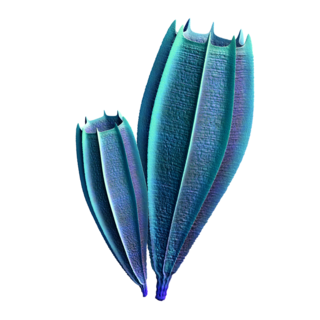
Takakkawia is a genus of sponge in the order Protomonaxonida and the family Takakkawiidae. It is known from the Middle Cambrian Burgess Shale that reached around 4 cm in height. Its structure comprises four columns of multi-rayed, organic spicules that align to form flanges. The spicules form blade-like structures, ornamented with concentric rings.
Eiffelia is an extinct genus of sponges known from the Middle Cambrian Burgess Shale as well as several Early Cambrian small shelly fossil deposits. It is named after Eiffel Peak, which was itself named after the Eiffel Tower. It was first described in 1920 by Charles Doolittle Walcott. It belongs in the Hexactinellid stem group. 60 specimens of Eiffelia are known from the Greater Phyllopod bed, where they comprise 0.11% of the community.

Halichondrites, sometimes mis-spelt Halicondrites is an extinct genus of sea sponge known from the Middle Cambrian Burgess Shale. 7 specimens of Halichondrites are known from the Greater Phyllopod bed, where they comprise < 0.1% of the community.
Hamptonia is an extinct genus of sea sponge known from the Middle Cambrian Burgess Shale and the Lower Ordovician Fezouata formation. It was first described in 1920 by Charles Doolittle Walcott. 48 specimens of Hamptonia are known from the Greater Phyllopod bed, where they comprise < 0.1% of the community.
Leptomitus is a genus of demosponge known from the Middle Cambrian Burgess Shale. Its name is derived from the Greek lept ("slender") and mitos ("thread"), referring to the overall shape of the sponge. 138 specimens of Leptomitus are known from the Greater Phyllopod bed, where they comprise 0.26% of the community.

Pirania is an extinct genus of sea sponge known from the Middle Cambrian Burgess Shale and the Ordovician Fezouata formation. It is named after Mount St. Piran, a mountain situated in the Bow River Valley in Banff National Park, Alberta. It was first described in 1920 by Charles Doolittle Walcott. 198 specimens of Pirania are known from the Greater Phyllopod bed, where they comprise 0.38% of the community.
Wapkia is an extinct genus of sea sponge with radial sclerites, known from the Middle Cambrian Burgess Shale. It was first described in 1920 by Charles Doolittle Walcott. 32 specimens of Wapkia are known from the Greater Phyllopod bed, where they comprise 0.06% of the community.

Choiaella is an extinct genus of sea sponge ranging from the Chengjiang lagerstatten until the Lower Silurian.

Hazeliidae is an extinct family of spicular Cambrian sea sponges known from the Burgess Shale, the Marjum Formation of Utah, and possibly Chengjiang. It was described by Charles Walcott in 1920.

The Marjum Formation is a Cambrian geological formation that overlies the Wheeler Shale in the House Range, Utah. It is named after its type locality, Marjum Pass, and was defined in 1908. The formation is known for its occasional preservation of soft-bodied tissue, and is slightly younger than the Burgess Shale, falling in the Ptychagnostus praecurrens trilobite zone.

Reticulosa is an extinct order of sea sponges in the class Hexactinellida and the subclass Amphidiscophora. Reticulosans were diverse in shape and size, similar to their modern relatives, the amphidiscosidans. Some were smooth and attached to a surface at a flat point, others were polyhedral or ornamented with nodes, many were covered in bristles, and a few were even suspended above the seabed by a rope-like anchor of braided glass spicules.
Heteractinida is an extinct grade of Paleozoic (Cambrian–Permian) sponges, sometimes used as a class or order. They are most commonly considered paraphyletic with respect to Calcarea, though some studies instead argue that they are paraphyletic relative to Hexactinellida. Heteractinids can be distinguished by their six-pronged (snowflake-shaped) spicules, whose symmetry historically suggested a relationship with the triradial calcarean sponges.
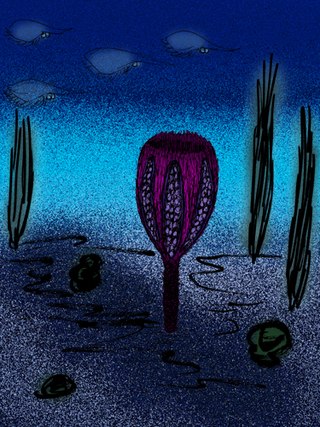
Eiffeliidae is an extinct family of sponges.

This is a list of the biota of the Burgess Shale, a Cambrian lagerstätte located in Yoho National Park in Canada.












